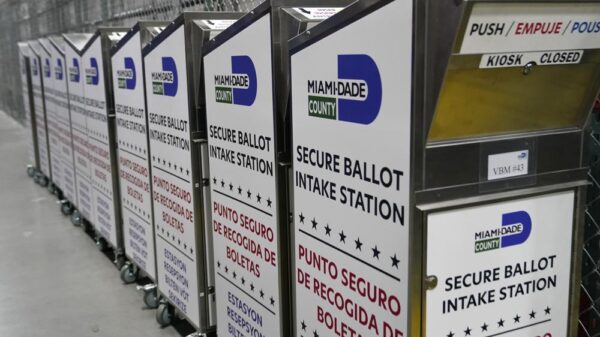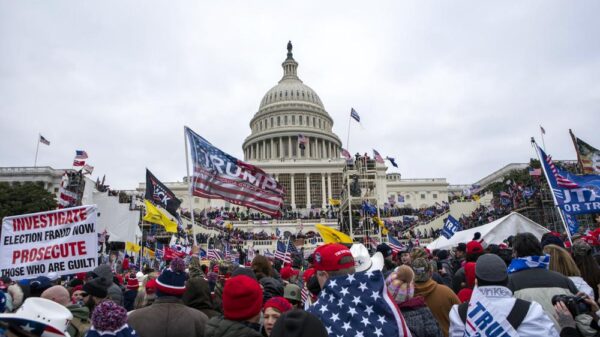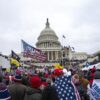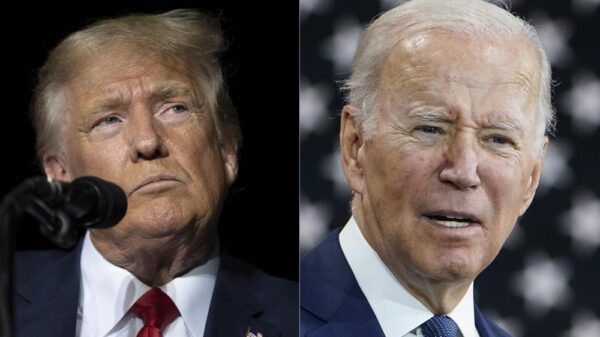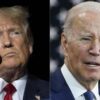FILE – In this July 26, 2018, file photo President Donald Trump speaks at the United States Steel Granite City Works plant in Granite City, Ill. Trump spent four years upending seven decades of American trade policy. He started a trade war with China, slammed America’s closest allies by taxing their steel and aluminum and terrified Big Business by threatening to take a wrecking ball to $1.4 trillion in annual trade with Mexico and Canada. Trump’s legacy on trade is likely to linger, regardless whether Joe Biden replaces him in the White House in January 2021. (AP Photo/Jeff Roberson, File)
WASHINGTON (AP) — President Donald Trump spent four years upending seven decades of American trade policy.
In what became his defining economic act, Trump launched a trade war with China. On another front, he taxed the steel and aluminum of U.S. allies. And he terrified America’s own corporations by threatening to wreck $1.4 trillion in annual trade with Mexico and Canada.
He did it in typically combative, mercurial style — raising tariffs, hurling threats, walking them back, sometimes reopening conflicts that had seemed resolved.
All of it came wrapped in a singular message, delivered with a Trumpian roar: America had too long been exploited by horrendous deals forged by his predecessors. From now on, he proclaimed, America would come first, its trading partners a distant second.
Yet for all the drama that drove his confrontational policies for four years, it comes down to this: Not very much really changed.
America’s deficit in goods and services now exceeds what it was under President Barack Obama. Steel and aluminum makers have cut jobs despite Trump’s protectionist policies on their behalf. His deals made scarcely a ripple in a $20 trillion economy. For most Americans, Trump’s drastic trade policy ultimately meant little, good or bad, for their financial health.
Whether Trump wins a second term or Joe Biden unseats him, though, much of his legacy on trade seems likely to endure. His hardline stance toward China will probably outlast his presidency for this reason: It reflected and shaped a belief, of Democrats and Republicans alike, that Beijing had long violated its vows to treat foreign businesses fairly, committed predatory trade practices and bullied other nations on the global stage.
Notably, Biden hasn’t said whether he would retain the tariffs Trump imposed on about $360 billion in Chinese goods — well over half of what Beijing ships to the U.S. every year.
“They won’t say they’re going to flush this or flush that,” U.S. Trade Representative Robert Lighthizer said of the Biden team in an interview. “The only thing you can do is what we did or go back to where they were. Nobody wants to go back to where we were.”
Gone are hopes that the United States might coax China into curbing its unfair policies through patient negotiations or by bringing disputes to the World Trade Organization.
“One of the reasons we got to where we were with Trump is that we exhausted the other options,” said Wendy Cutler, a former trade negotiator who is now at the Asia Society Policy Institute. “We tried suing them in the World Trade Organization. We had a lot of victories… But, that said, China didn’t change.”
Still, Cutler is unimpressed with Trump’s approach: “Given all the rhetoric, if you look at the results of what he did — they’re modest.″
Before Trump, American policymakers had mainly promoted ever-freer global trade, governed by WTO rules. The Obama administration painstakingly negotiated the Trans-Pacific Partnership with 11 other countries but excluded China to try to diminish Beijing’s influence and pressure it to adopt reforms.
In his first week in office, Trump abandoned the TPP. And last year, he neutered the WTO by refusing to approve new judges to its version of the Supreme Court.
Under Trump, freer trade — long a pillar of Republican policy in the United States — was out. “America First” protectionism was in.
“It’s a very big shift,” said Phil Levy, an economic adviser under President George W. Bush who is now chief economist at the freight company Flexport. Trump attacked longstanding free-trade policies “with axes and saws,” Levy said.
Trump set his sights on shrinking America’s vast trade deficits, portraying them as evidence of economic weakness, misbegotten deals and abusive practices committed by other countries. He pledged to boost exports and to curb imports by imposing tariffs — import taxes — on many foreign goods.
To that end, he fought with China, taxed foreign steel and aluminum and forced Canada and Mexico to renegotiate a North American trade pact, among other things.
Yet the belligerent approach has made scant difference in the number he cares about most: The overall trade deficit in goods and services. It barely dipped last year — by 0.5% to $577 billion, still higher than in any year of the Obama administration. This year, the gap has widened nearly 6%, with the coronavirus pandemic having crushed tourism, education and other service “exports.”
Declaring himself a “Tariff Man,” Trump famously announced early on that “trade wars are good and easy to win.” History suggests that trade victories are actually hard to achieve and almost always inflict collateral damage. Predictably, China and other countries retaliated with tariffs of their own, many of them targeting American farmers. The uncertainty fanned by Trump’s mercurial policymaking led many businesses to delay investments that would have supported the economy.
Contrary to his assertions, too, Trump’s tariffs have been paid by American importers, not foreign countries. And their cost is typically passed on to consumers in the form of higher prices. Researchers from the Federal Reserve Bank of New York and Princeton and Columbia universities have estimated that the president’s tariffs cost $831 per U.S. household annually.
“His administration’s approach has delivered few tangible benefits to the U.S. economy while undercutting the multilateral trading system, disrupting long-standing alliances with U.S. trading partners and fomenting uncertainty,” said Eswar Prasad, a Cornell University economist who formerly led the International Monetary Fund’s China division.
Talan Products, a $50 million-a-year metal stamping company in Cleveland, said it missed out on two major projects because Trump’s tariffs raised the cost of its imported parts, allowing Indian competitors to underprice Talan’s bids.
“Without the tariffs, we would have been a little more competitive,” said Steve Peplin, the company’s CEO. “It would have been nice to have another $5 million or $10 million a year.”
The full consequences of Trump’s policies may take longer to emerge. His revamped North American trade pact took effect only July 1. And the results of an interim pact he reached with China in January have been clouded by the pandemic recession.
“It may prove to be a good strategy,” said Blake Hurst, a soybean and corn farmer who is president of the Missouri Farm Bureau. “But there are costs to it — costs to our reputation, costs to our future ability to negotiate … It’s a high-risk strategy that we’ve embarked upon, and we don’t know the results yet.”
Copyright 2020 Associated Press. All rights reserved.





































